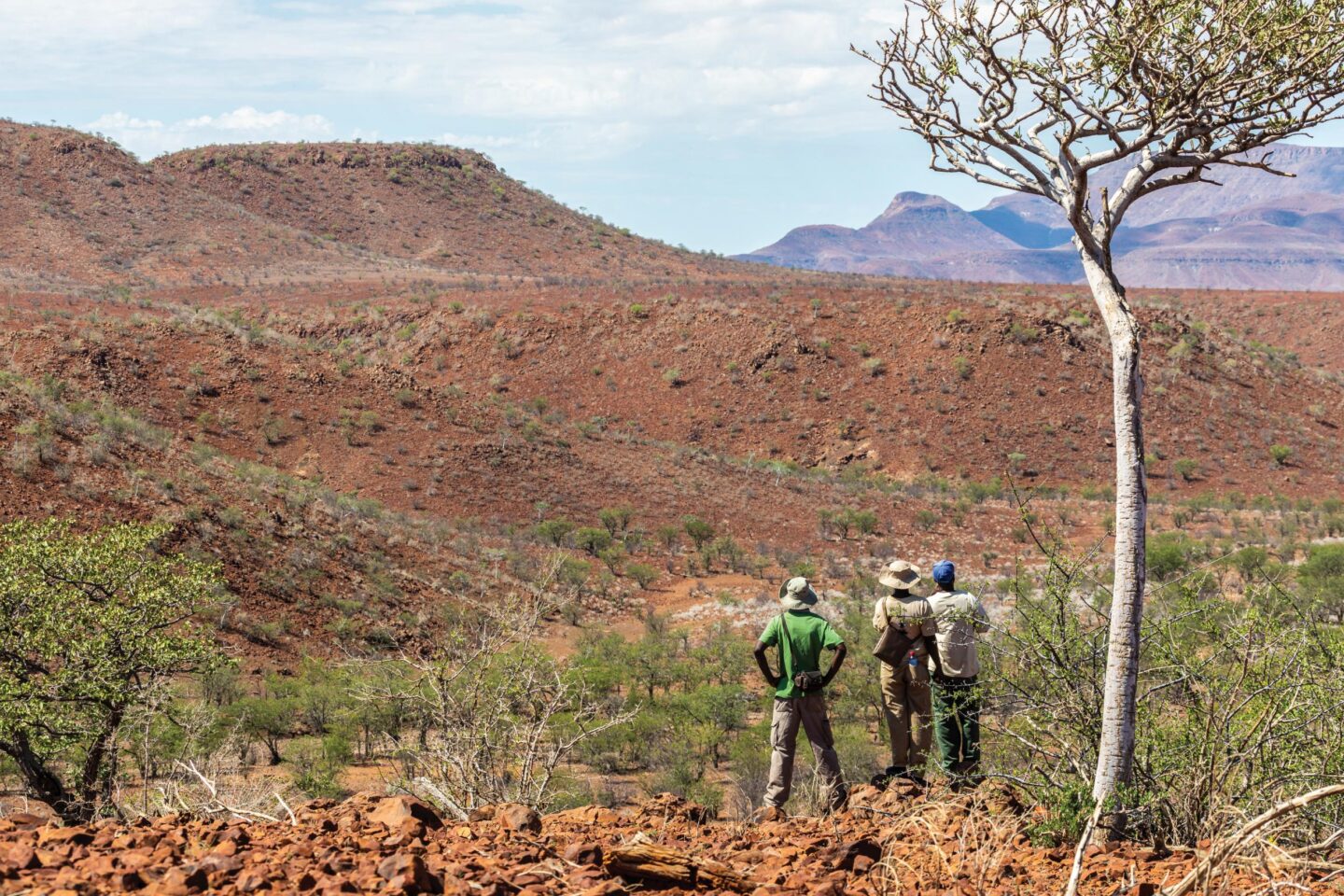

Slow and steady
The interminable resilience of the people of the ≠Khoadi-//Hôas Conservancy
We met Lorna at the ≠Khoadi-//Hôas Conservancy office. Tucked into the dry mopane woodland of Namibia’s north-western Damaraland, the office looks like just another house in the region. Slightly dated, but with all the necessities. There’s a fence that keeps wildlife out and, parked under a roof, a Land Cruiser bakkie to get around. My quick glance at the bakkie doesn’t answer the question of whether it actually runs or not. For their sake, I really hope it does. This is tough country. It’s tough on the back of a bakkie, but even tougher on foot.
From the Autumn 2021 issue
We find a spot in the shade and Lorna and I catch up on what’s been happening since the last time I had the pleasure of visiting the conservancy. The answer: not much. Not much of anything has happened in this slow- paced part of Namibia. Not much rain, even less tourism. But life goes on. It ebbs and flows at the pace of nature. Slow, but steady. That’s how the communities who live in these far-flung rural areas tackle life. Slow and steady. It’s how they tackle their challenges and how they tackle the enormous conservation tasks that have been placed in their capable hands as well.
After our shaded catch-up session we set off for the nearby settlement of Anker. To call it a town would be a bit overzealous. Perhaps village is the most apt description. It is here, in the small village of Anker, that the ≠Khoadi-//Hôas Conservancy has taken up its latest task. After an earthquake left some parts of the school and the hostels of Anker’s Edward Garoeb Primary unfit for habitation over three years ago, the local children were sent to school near Fransfontein, almost 150 km away. The community suffered at the loss of the school and the added burden of having to send their kids so far away. Transport is not an easy thing to come by in these parts, and something as simple as sending your daughter, who suddenly lives 150 km away, a new bottle of shampoo can sometimes prove too costly.
Now, the conservancy, with support from Grootberg Lodge and Journeys Namibia, has teamed up to build temporary housing for the children from nearby farms so that they can once again return to Edward Garoeb School, until such time that the government is able to rebuild the hostels damaged by the earthquake.
I watch a young mother, with a baby strapped to her back, carry bricks back and forth at the construction site. Another lady, at least 6 months pregnant by my uneducated guess, shovels a large heap of sand through a sieve before it is put into a concrete mixer. Men and women of all ages are busy laying bricks, mixing cement and with other construction-related activities. They are local residents building a new home for their community’s children… by hand. They are undertaking this task completely free of charge, with only the cost of the building materials being covered by the conservancy and sponsors’ tremendous input into the endeavour. Slow and steady, they are solving their own problems.
The next morning we set off on what feels like a back-cracking journey down Grootberg into the Klip River valley. Each time my body complains of an ache or cramp brought on by a particularly bumpy stretch of jeep track, my mind replays the image of that lady carrying bricks with an infant on her back. Four or five hours later (I lost track) and many kilometers of driving and then hiking over the rugged terrain, I sit on a rock next to a game guard employed by the conservancy. We’re peering through our binoculars at a young rhino cow as she stands beneath the shade of a large mopane in the dry ephemeral Klip River. We’ve been tracking her most of the morning, and the sun is beating down with a scorching vengeance from its noon position overhead. My companion does this most days. For shifts of up to 21 days at a time, these community game guards track and monitor rhino activity in the area, always on the lookout for signs of two- legged insurgents that are looking to take what does not belong to them. No-one needs a rhino horn other than a rhino.
That’s the way of life here on the Grootberg. The Big Mountain. A conservancy, a community, banded together to protect their natural heritage and each other. It’s not an easy life, but it’s theirs. And what I find each time I return, and with each conversation I have around a campfire, is a sense of ownership and immense pride. Pride that they are incredibly worthy of. TNN
More Journeys inspiration: www.journeysnamibia.com
The ≠Khoadi-//Hôas Conservancy was one of the first four conservancies established in Namibia in the mid- 90s when the government implemented the Community- based Natural Resource Management (CBNRM) programme. The other three are Nyae Nyae in the east near former ‘Bushmanland’, Salambala in the Zambezi Region and Torra in the Kunene Region.
Grootberg Lodge was the very first lodge in Namibia to be fully owned by the local community. With the help of donor funding and loans, the community has set up a completely unique ownership model within the Namibian tourism industry framework. Unlike other joint-venture tourism projects, where investors build lodges and pay a levy to the community, the entire infrastructure and all the fixed assets of Grootberg Lodge are owned by the community. Journeys Namibia participates in the capacity of lodge management and marketing, for which a management fee is paid.






